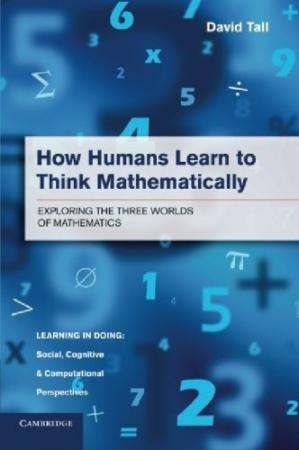How Humans Learn to Think MathematicallyExploring the Three Worlds of Mathematics
|

|
 Diese Seite wurde seit 4 Jahren inhaltlich nicht mehr aktualisiert.
Unter Umständen ist sie nicht mehr aktuell.
Diese Seite wurde seit 4 Jahren inhaltlich nicht mehr aktualisiert.
Unter Umständen ist sie nicht mehr aktuell.
 Zusammenfassungen
Zusammenfassungen
 How Humans Learn to Think Mathematically describes the development of mathematical thinking from the young child to the sophisticated adult. Professor David Tall reveals the reasons why mathematical concepts that make sense in one context may become problematic in another. For example, a child's experience of whole number arithmetic successively affects subsequent understanding of fractions, negative numbers, algebra, and the introduction of definitions and proof. Tall's explanations for these developments are accessible to a general audience while encouraging specialists to relate their areas of expertise to the full range of mathematical thinking. The book offers a comprehensive framework for understanding mathematical growth, from practical beginnings through theoretical developments, to the continuing evolution of mathematical thinking at the highest level.
How Humans Learn to Think Mathematically describes the development of mathematical thinking from the young child to the sophisticated adult. Professor David Tall reveals the reasons why mathematical concepts that make sense in one context may become problematic in another. For example, a child's experience of whole number arithmetic successively affects subsequent understanding of fractions, negative numbers, algebra, and the introduction of definitions and proof. Tall's explanations for these developments are accessible to a general audience while encouraging specialists to relate their areas of expertise to the full range of mathematical thinking. The book offers a comprehensive framework for understanding mathematical growth, from practical beginnings through theoretical developments, to the continuing evolution of mathematical thinking at the highest level. Bemerkungen zu diesem Buch
Bemerkungen zu diesem Buch
 This is, I believe, the first book to focus on the full framework of mathematical thinking as it develops from birth through to adulthood and on to the frontiers of research.
This is, I believe, the first book to focus on the full framework of mathematical thinking as it develops from birth through to adulthood and on to the frontiers of research. Warum ich dieses Buch im Biblionetz erfasst habe: In diesem Buch geht es um das mathematische Denken und der Autor hat ein entsprechendes Modell entwickelt. Da ich mich u.a. mit informatischem Denken (computational thinking) beschäftige, ist es spannend zu sehen, wie ein anderes Fachgebiet ihre eigene Denkweise modelliert.
Warum ich dieses Buch im Biblionetz erfasst habe: In diesem Buch geht es um das mathematische Denken und der Autor hat ein entsprechendes Modell entwickelt. Da ich mich u.a. mit informatischem Denken (computational thinking) beschäftige, ist es spannend zu sehen, wie ein anderes Fachgebiet ihre eigene Denkweise modelliert. Kapitel
Kapitel 
- 1. About this book (Seite 3 - 29)


 Dieses Buch erwähnt ...
Dieses Buch erwähnt ...
 Personen KB IB clear | Jerome S. Bruner , Mark Johnson , G. Lakoff | |||||||||||||||||||||||||||||||||||||||||||||
 Begriffe KB IB clear | Axiomatic formalism
, Conceptual embodiment
,  Denken Denken thinking
, EmbodimentEmbodiment
, thinking
, EmbodimentEmbodiment
,  enaktive Repräsentation
, Formal-operatives Denkenformal operational stage
, enaktive Repräsentation
, Formal-operatives Denkenformal operational stage
,  ikonische Repräsentation ikonische Repräsentation iconic representation
, iconic representation
,  Mathematik Mathematik mathematics
, Operational symbolism
, mathematics
, Operational symbolism
,  Repräsentationstrias / EIS-Prinzip
, Repräsentationstrias / EIS-Prinzip
,  symbolische Repräsentation symbolische Repräsentation symbolic representation
, symbolic representation
,  three worlds of mathematics three worlds of mathematics
| |||||||||||||||||||||||||||||||||||||||||||||
 Bücher |
|
 Dieses Buch erwähnt vermutlich nicht ...
Dieses Buch erwähnt vermutlich nicht ... 
 Tagcloud
Tagcloud
 Zitationsgraph
Zitationsgraph
 Zitationsgraph (Beta-Test mit vis.js)
Zitationsgraph (Beta-Test mit vis.js)
 Volltext dieses Dokuments
Volltext dieses Dokuments
 | How Humans Learn to Think Mathematically: Gesamtes Buch als Volltext ( : :  , 5524 kByte) , 5524 kByte) |
 |  About this book: Kapitel als Volltext ( About this book: Kapitel als Volltext ( : :  , 184 kByte; , 184 kByte;  : :  ) ) |
 Bibliographisches
Bibliographisches 
 Beat und dieses Buch
Beat und dieses Buch
Beat hat dieses Buch während seiner Zeit am Institut für Medien und Schule (IMS) ins Biblionetz aufgenommen. Beat besitzt kein physisches, aber ein digitales Exemplar. (das er aber aus Urheberrechtsgründen nicht einfach weitergeben darf). Es gibt bisher nur wenige Objekte im Biblionetz, die dieses Werk zitieren.














 Biblionetz-History
Biblionetz-History